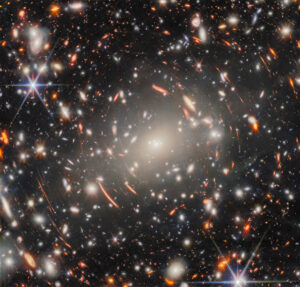
Erica Nelson ’08
Erica Nelson ’08 is aiming beyond the stars, to the origin story of the universe. Thanks to the 2021 launch of the James Webb Space Telescope, Nelson is taking pictures of the very first galaxies to learn what the universe was like at the beginning of time.
That quest has landed the University of Colorado-Boulder assistant professor of astrophysics on CBS’s 60 Minutes and NPR’s Science Friday—and on an episode of the Pomona College podcast Sagecast, where she and her undergraduate mentor, Philip Choi, associate professor of physics and astronomy, explained the paradigm-shifting potential of what she and her colleagues have discovered.
How Pomona developed her interest:
I remember my first astrophysics classes and being absolutely blown away by the scale of the universe and the incredibly complex physical processes that rule the universe on large scales. We can use powerful telescopes to effectively look back in time. As a kid I found that concept so mind-blowing that I couldn’t imagine spending my days thinking about anything else.
One of my favorite Pomona memories solidified that I wanted to teach and help the next generation. We had a computer programming assignment for Philip Choi’s class, and it was awful because I was so bad at coding. But Phil took the time to work through it with me until midnight. It was such an act of kindness and really launched me on my journey.
Her research focus:
I’m looking for new methods to understand how galaxies and black holes form and evolve. Powerful telescopes like the Webb allow us to see really, really great distances. That means we can see light that’s been traveling for almost the entire age of the universe, from close to the beginning of time itself. We’re able to see how the universe and the galaxies in it evolved, and that allows us to piece together their origin story.
Finding a surprise in Webb images:
When the first images were released, the most surprising thing we saw was these objects that were very, very red. They had been completely invisible to the Hubble Telescope. We had to use all of the physics and astrophysics we knew to try to infer what those objects were. They are incredibly far away, close to the beginning of the universe. Yet the masses we inferred for them were even more massive than our Milky Way galaxy is now. According to our theories, the universe shouldn’t have had enough time to form things that were that massive that early. It was surprising and stunning and, if true, upends our views of how the first cosmic structures formed in the early universe.
The reaction of the astronomy community:
There have been hundreds of papers on these [red] objects, and we are still figuring out what they are. One of the things that is surprising is that some of the most luminous objects in the universe are actually “supermassive black holes” [upward of 10 billion times the size of the sun]. There are some theories that can explain some components of the light we’re seeing from these objects as growing, supermassive black holes of a type we’ve never seen before.
The reason black holes can be so luminous is that when mass falls into a black hole, an immense amount of gravitational energy is released. Some fraction of that energy can be converted into light we see in the form of accretion disks around the objects and in these black holes blowing out enormous jets. They show up in different ways, but the reason they are so luminous is because there is so much energy available from matter falling into them. The astrophysics community is completely undecided on what these objects are. They are a complete mystery that we’re still working very hard to solve it.
(Wide) open problems that remain:
A long-standing problem in extragalactic astrophysics is that at the center of every massive galaxy is a supermassive black hole, and we do not know how it got there.
One of the possibilities … is a direct collapse black hole. Most black holes are the end product of the evolution of stars, which are powered by nuclear fusion. Once the [stars] have used up all of their fuel, they no longer have anything to support them against the immense force of gravity, and they collapse. If they are massive enough, there is nothing that can prevent them from collapsing into black holes.
But that only gets you to black holes that are on the scale of the mass of a star. The thing we need at the center of these galaxies is black holes that are millions to billions of times the mass of a star. It’s the subject of a lot of debate how you actually get a black hole that massive.
One of the possibilities for some of this light we’re seeing in the very early universe—which we’ve recently found evidence for—is the formation of a supermassive black hole directly from a cloud of gas without forming any stars. They look like stars, but instead of being powered by nuclear fusion, they are powered by growing supermassive black holes inside of them.
These are very strange objects. Understanding them is still very much a work in progress. It’s challenging, but not impossible, to truly understand the formation of the first lights that lit up the cosmic night.
This interview has been edited for length and clarity. Listen to the full interview in Season 7 of the Sagecast Podcast.

